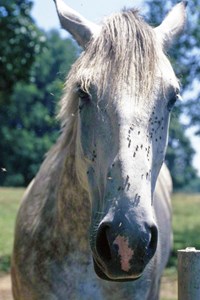Horses bedeviled by black flies may soon find relief from an unusual source: a substance produced by badgers to ward off wasps.

Technically known as a semiochemical, the substance was discovered by French researchers studying a strange fact about badgers: “They attack wasp nests and seem naturally protected from wasps,” says Benjamin Creton, MSc, of the Research Institute in Semiochemistry and Applied Ethology in Apt, France.
Semiochemicals are released into the environment by mammals to communicate with or influence the behavior of other organisms.
“Chemical communication is the most ancient way of communicating among living beings,” explains Creton. “Each species owns its specific receptors, which are capable of detecting important information released by conspecifics or other individuals. The semiochemicals may have various functions. Between individuals belonging to the same species, we will observe sexual pheromones, maternal-appeasing pheromones, alarm pheromones or territorial marking pheromones.”
He continues: “In the special case of parasites, some semiochemicals will be responsible for the detection of the most accurate host—they will attract the parasite–while others will make it possible to avoid inappropriate hosts.”
The researchers soon learned that the badger semiochemical provided protection not only against wasps, but three different types of mosquitoes. “Knowing the noxious impact of simulids (black flies) on horses, and taking into account that they are genetically not that far from mosquitoes, we decided to test this substance in that application,” says Creton
For the first part of their study, the researchers applied a 3 percent solution of the semiochemical to the ears of 20 horses and observed them, along with untreated control horses, for one hour. They counted the number of black flies that landed on the ears of each animal. That data showed that the semiochemical had a 90 percent efficacy rate in keeping flies off of horse’s ears.
In the second phase of the study, the researchers applied a slow-release formulation of the semiochemical to each horse’s ears and counted black flies for 60 minute periods at eight, nine and 10 hours after treatment. The resulting data showed consistent results in each period, with fly-repelling efficacy rates of over 98 percent.
Creton says that, based on this success, a commercial product utilizing badger semiochemicals is under development. “We have signed an agreement with a partner, and they are currently developing a commercial product. According to their information, there is a reasonable hope to expect a commercial product in spring 2017.”
Reference: “Protection of horse ears against Simulid parasitism: Efficacy of a mammal semiochemical solution over 10 hours,” Veterinary Parasitology, August 2016
This article first appeared in EQUUS issue #471, December 2016.








